[/caption]
If this isn’t one of the most breathtaking space pictures ever, I don’t know what is. It’s the ISS at its full and final length, with all four sets of solar arrays unfurled, against the limb of Earth. The STS-119 mission successfully did its job of bringing up and installing the final set of solar array wings, giving the ISS the “finished” look we’ve all been waiting for. There are a few more modules to bring up, but none so big as the solar arrays. And now the space station is the second brightest object in the night sky, second only to the Moon. Click on the image to download a hi-resolution version.
Space shuttle Discovery returned home on Saturday, March 28 landing at 3:14 pm EDT. The weather and winds cooperated, allowing the spacecraft to land on the second opportunity of the day. Enjoy more images from the highly successful mission below.
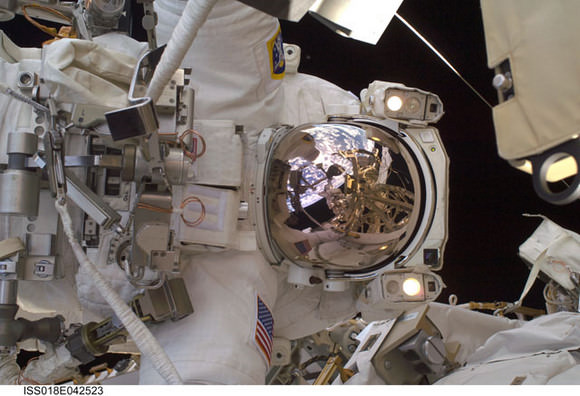
An astronaut at work. Ricky Arnold, STS-119 mission specialist, works outside the space staton during the mission’s third extravehicular activity (EVA), doing a few construction and maintenance tasks during the six-hour, 27-minute spacewalk.
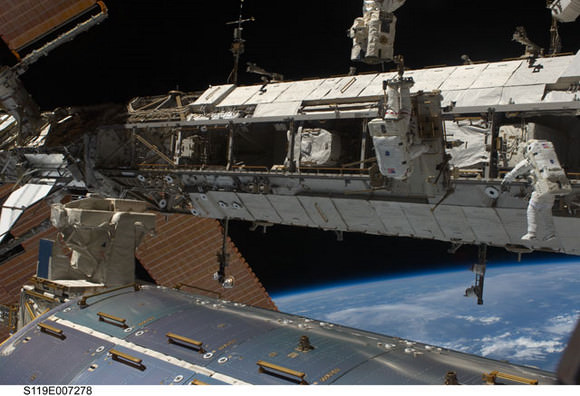
This is a great image that makes you appreciate how big the space station is. Ricky Arnold (right) and Joseph Acaba worked during the third EVA of the mission to help robotic arm operators relocate the Crew Equipment Translation Aid (CETA) cart from the Port 1 to Starboard 1 truss segment, lubricated the space station’s robotic arm and performed a few other “get ahead” tasks.
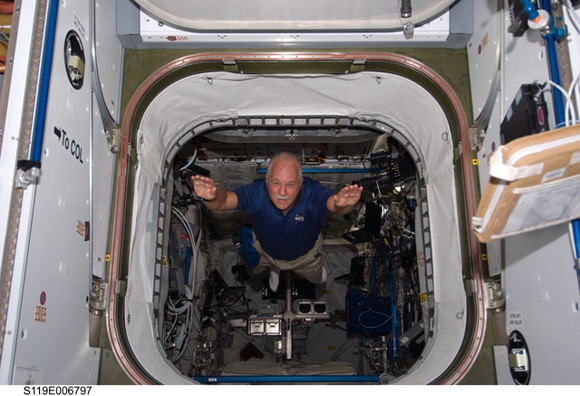
I think almost everyone dreams of doing this: flying. But this was no dream for astronaut John Phillps — he really was flying through the ISS. It sure looks like fun!
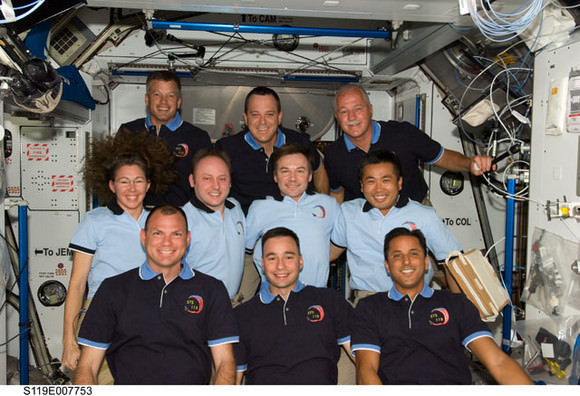
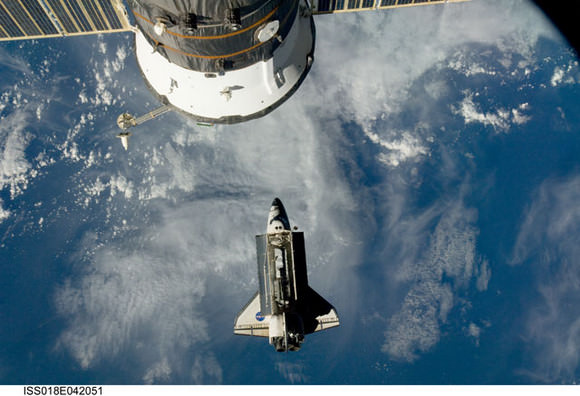
Here’s a nice image of the space shuttle approaching the space station, backdropped by a blue and white Earth, as the shuttle gets ready for rendezvous and docking with the ISS.

Commander Lee Archambault nails the landing as Discovery touches down on the runway at Kennedy Space Center.
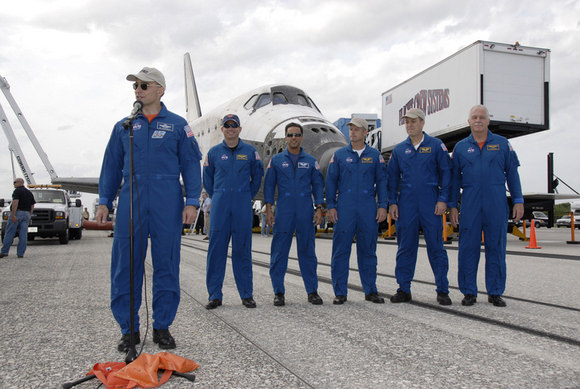
Discovery crew members spoke after the landing on Saturday, and after the traditional walk-around of the spaceshuttle. Commander Lee Archambault introduced five of the seven members of the STS-119 mission crew. Ricky Arnold remained in the crew quarters, as well as returning ISS crewmember Sandy Magnus, taking things a little slower after her 130-day stint in space.
More images of the mission are available in our previous article, and find all the mission images at NASA’s Human Spaceflight webpage. Here’s another article that has a video of the ISS as the shuttle Discovery departed last week.

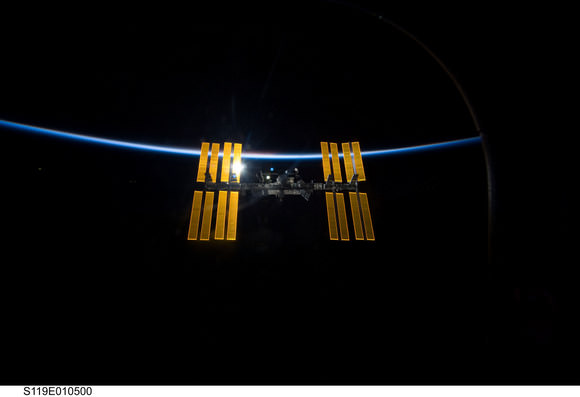
WOW! That first image is an absolute stunner! What an amazing bit of beauty only possible by science and technology!
Of course, it’s now my desktop image. That pretty much goes without saying.
It’s on my desktop, too, Jorge!
Wow! The first one is beautiful, as well as these stunning High-Definition videos:
http://www.astroversum.nl/nieuws/29032009/hd-video-lancering-en-landing-van-shuttle-discovery/
The first one reminds me of the “flying spaghetti monster”. Strange, but somehow…. 😉
Hey, one of those astronauts has grey hair and looks like a postman. There is hope for the rest of us yet!
I thought they were clips on the laundry 😀
I’ve never bothered to look for the ISS. I’ll have to take a look.
The first satellite I saw was Sputnik 1 (booster) 48 hours after it was launched.
The Echo satellites were fun to watch.
I’m getting old now and I wait for warmer weather. Real nice now, over 80 degrees.
My favorite thing that I have watched was the Apollo 8 broadcast from lunar orbit.
does someone have a high res version of the first picture?
duff– go to the link at the end from NASA’s Human Spaceflight website, and all the images are available in hi res.
Ok, due to popular demand, just click on the first image to download a hi-res version. Same with the second one, too, of Ricky Arnold on EVA.
Beaurifull images Nancy !
If you zoom in on the faceplate in hi-res- you can see the reflection of the other astronaut taking this picture- Neat stuff-
The ISS has never been my favorite project. I think that the money could have been better spent on other space projects. That said, the ISS takes and provides stunning photograhps. That first one should be an instant iconic photo. It is simply beautiful. What a wonderful combination of man’s technology and the natural universe. To anyone who thinks that money spent on the space program overall is wasted, I say it has been and will continue to be the best way to waste money that I can think of.
Wow – that first image is a stunner. Very art.
I agree, a stunner! Makes one appreciate just how thin our Earth’s atmosphere really is!
Does anyone know what the three small objects to the left of the ISS are in the first image?
I believe I’ve seen quite a few pictures from ISS over and around the earth. But wonder what the blue ring around the earth are, and that I, apparently is the only one, who is wondering about this phenomena. does anyone have an explanation?
Hi Steve –
Having opened the image in photoshop, and ramped up the light levels, I’d say that the three small ‘objects’ are reflections in the orbiter window, through which the image was taken…
Of course I could be wrong ; )
Nathanial
harrybody- its Earth’s atmosphere, backlit by the sun.
Call me when the ISS does something worthy of its $100 billion price tag.
Can’t put a price-tag on human curiosity and spirit.
I agree, but I don’t see much adventure with the ISS, unless you consider endless maintenance and a few experiments that could have been done for a fraction of the cost adventure.
And please don’t tell me the ISS is a stepping stone to the Moon, Mars, and beyond. It is going to be trashed in 2016 and I guarantee you most of the experience and technology for those true adventures won’t come from the ISS.
How many astronauts who are on the ISS now will even be around when we finally send humans to Mars?
I don’t mind seeing a space station, but the ISS ain’t what I had in mind.
Huygens, before we condem the ISS, we must wait to see what science comes of it!
I have a feeling that what will be found is not what was expected but may be just what we need…
Specifically advances in:
Materials engineering
E/M field generation
Robotics
Medicine – pharmaceuticals
Genetic engineering
Astrophysics
Astronomy
etc..
How about “quite” some experience on constructing in space. I think the participants have build quite a list of do’s and don’ts gathered over the years.
And also maybe in terms on international co-operation when there is a need!!!
Well, I’ve waited 11 years for anything to stand out about the ISS, guess I can wait a few more, right?
I just want to know where my $100 billion went, tis all.
My problem is I grew up in an era where a President said we were going to put a man on the Moon by the end of the decade and we actually did it.
How many more decades will it be before even the first set of humans step on Mars?
Three at least judging by NASA’s lack of committment.
But those solar panels do look pretty glinting in the sunlight like that, I must say.
$100 billion for some pretty pictures.
And you wonder why Joe Sixpack doesn’t understand or appreciate space travel.
There are still some who feel that science itself is wrong and a burden on the human race, but do a good research. See what improvements have been made in computers, materials of many kinds (from metals to fabrics), medicine (for many different reasons!), and who knows what I can’t think of off the top of my head. As space work advances, so do many sciences in relation to that work.